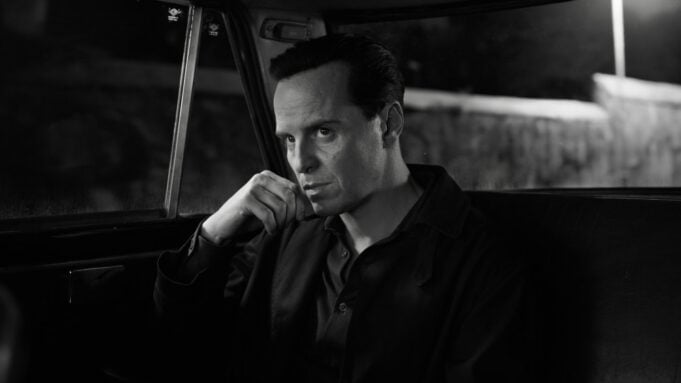Patricia Highsmith’s 1955 crime novel, “The Talented Mr. Ripley,” is regarded as one of the greatest thrillers of all time. It has spawned several film adaptations, including Anthony Minghella’s “The Talented Mr. Ripley,” starring Matt Damon and Jude Law. Given the 1999 movie’s commercial and critical acclaim, a series adaptation for the streaming era was almost inevitable, and after being sold off by Showtime to Netflix, “Ripley” has Andrew Scott stepping into the titular character’s loafers. Academy Award-winning writer-director Steven Zaillian — behind such works as “Schindler’s List” (for which he won the adapted screenplay Oscar) and the 2016 HBO limited series “The Night Of ” — presents his own spin on the psychological thriller. Twisted and deeply disturbing, this “Ripley” feels more sinister and stilted than its predecessors, making the show arduous rather than enticing.
Shot in magnificent black and white, “Ripley” opens in Rome in 1961 as a man drags a dead body down a marble staircase. But the story doesn’t begin here. Dialing back in time six months, we find ourselves on New York’s Lower East Side. A far cry from the trendy neighborhood seen in films and TV shows today, the area is home to some of the Big Apple’s most unsavory citizens.
Here, in a cramped, rat-infested apartment, the audience is introduced to Ripley, a petty thief who makes his living tricking patients of chiropractors out of their money. Just as his latest scheme is drying up, he stumbles on the opportunity that will reshape his life forever. At a bar one evening, he’s approached by a private investigator (a criminally underused Bokeem Woodbine), who mistakes Tom for a friend of his wealthy client’s son. Shortly after, Tom is on a ship to Italy tasked with enticing his “friend” Dickie Greenleaf (Johnny Flynn) to return home to his concerned parents. Seeing his all-expense-paid trip to Europe and the Greenleafs’ wealth as the chance to grasp the lifestyle he believes he deserves, Tom sets off on a dark path marred by lies, deceit and murder.
More aesthetically pleasing than narratively engaging, “Ripley” reveals missteps in the very first episode. Since the characters are older than in previous adaptations (both Scott and Flynn are over 40), it’s implausible that the Greenleafs would send a man they don’t know in search of their adult son. Moreover, with his detached demeanor, Tom doesn’t even fake the affection or familiarity needed to carry off this ruse.
While Dickie, a novice and untalented painter, receives Tom warmly, his girlfriend, Marge (Dakota Fanning), is immediately suspicious of her beau’s supposed acquaintance. Her instincts are correct: By the end of Chapter I, “A Hard Man to Find,” Tom begins formulating his plans to take Dickie’s lavish life for himself. What’s hard to reconcile is that Tom is utterly charmless. He’s a quick thinker who can meticulously plot his way out of dark corners but Tom’s sociopathic personality and inability to show even a sliver of humanity make “Ripley” an uncomfortable, somber watch.
Still, the show is a stunning cinematic display, boasting lingering shots of Italy’s monuments, canals and architecture. But the episodes are painfully overlong and full of dead space. Since Tom spends a great deal of time alone, plotting his next moves or cleaning up his various bloody messes, viewers are forced to bide their time with him as he completes the laborious tasks (typing false documents, cleaning up evidence).
Additionally, though Tom is a narcissist with limited people skills, Dickie and Marge aren’t much better. Whether or not the viewer roots for Tom’s lies and schemes, the show’s central couple has very little depth. Dickie is aloof and naive, a trust-fund baby who’s had the world handed to him. While he certainly doesn’t deserve to be one of Tom’s victims, his lack of astuteness makes him easy, pitiful prey. Meanwhile, despite seeing through Tom’s facade, Marge allows her discernment to be bulldozed by a perceived rejection from Dickie; her ensuing character arc is a total letdown.
Love Film & TV?
Get your daily dose of everything happening in music, film and TV in Australia and abroad.
“Ripley” stumbles in part because Tom is void of seduction and likability. The series has none of the homoeroticism of Minghella’s film, which is disappointing because Scott’s sensuality has radiated off the screen in other roles. In addition to her first “Ripley” novel, Highsmith wrote four sequels showcasing the con artist scheming his way through France and Germany. As an older, more seasoned Tom, Scott’s take on the swindler might have been better aligned in one of those stories. Also, given Tom’s hate-laced mentions of the aunt who raised him, flashbacks from his childhood might have made for a more robust narrative, lending the character much-needed dimension.
Ultimately, “Ripley” fails to offer a new or intriguing perspective on the infamous scammer. Previous projects have presented a more inviting experience in which the audience becomes enamored of Tom’s treacherous designs. Here, over eight tepid episodes, he never undergoes any fundamental transformation. From the beginning, he is just a grating grifter who lacks finesse.
“Ripley” premieres April 4 on Netflix.
From Variety US































